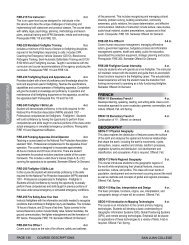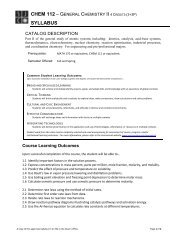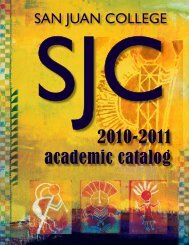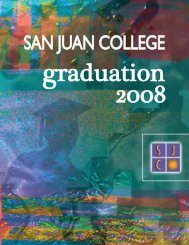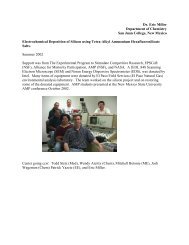AQIP 2007 Systems Portfolio - San Juan College
AQIP 2007 Systems Portfolio - San Juan College
AQIP 2007 Systems Portfolio - San Juan College
Create successful ePaper yourself
Turn your PDF publications into a flip-book with our unique Google optimized e-Paper software.
<strong>San</strong> <strong>Juan</strong> <strong>College</strong> – <strong>AQIP</strong> <strong>Systems</strong> <strong>Portfolio</strong>- November <strong>2007</strong>.school-aged students the chance to experience andprepare for college and/or earn college credit. Oncestudents are enrolled, key student support processessuch as placement testing, orientation, academicadvising, and registration activities help to positionstudents for success.The primary method to build and maintainrelationships with students is through collaborativeinteraction with program directors, faculty and supportstaff (see Table 3.3). Students stay with theirAdvising and Counseling Center advisor until criteriaare met (student has successfully completed allneeded developmental classes and has declared amajor) for transfer to core and specialty advisors.New student orientation provides an opportunity fornew students to connect with faculty, staff, advisors,student activities and other new students duringinformational and relationship building activities.Student relationships are also maintained throughouttheir academic careers through involvement with theStudent Activities office and other studentorganizations (see Category 1). A variety of clubsand service organizations, intramural athletics andcultural events offer opportunities for socialization forall types of students. Student interaction in theclassroom is sought through engagement in groupactivities, learning communities and facultyconnections. Efforts have been made to establish andsustain faculty interaction with students outside theclassroom. Through the use of student and faculty e-mail and traditional modes of communication such asfaculty office hours, students have a variety ofavailable options to communicate with instructors andacademic advisors on or off campus. The collegesurveys students to assure that satisfaction withprograms and services is kept with changing needsand expectations.3P3 SJC has long-standing relationships with its keystakeholders. These partnership processes aredesigned to achieve SJC’s mission and meetstakeholder needs. Alumni needs and expectationsare met through the <strong>San</strong> <strong>Juan</strong> <strong>College</strong> Foundation.Table 3.4. indicates a variety of means through whichchanging needs are identified so that appropriateresponses may be developed.Career Services develops and maintains theemployer relationship processes. Employers can postjob positions through Career Services andemployment opportunities are listed on the SJCwebsite. Employers and students are invited to aCareer Check each spring and Job Days.SJC also identifies the needs of employers throughthe Quality Center for Business (QCB). The QCBrepresents an integrated approach to assisting areaStudentsAlumniEmployersStakeholderCommunity and FeederSchoolsBoard of TrusteesPresidentTable 3.3 Stakeholder ContactsContactsAdvising and CounselingCenter staffProgram directorsClassroom instructorsFinancial Aid staffProgram DirectorsDirector of Career ServicesDeansDirector, Business andIndustry TrainingProgram DirectorsDirector of AdmissionsDirector of Tech ProgramDirectors, East and WestCentersDean, Continuing Educationand CommunityDevelopmentPresidentbusinesses, industry and organizations with businessdevelopment, economic development and businesstraining. <strong>San</strong> <strong>Juan</strong> <strong>College</strong> sponsors, or activelyparticipates in, five major programs, all located on-siteat the Quality Center for Business (see Categories 2and 9):• Enterprise Center• <strong>San</strong> <strong>Juan</strong> Economic Development Service• Small Business Development Center• Northwest New Mexico Council of Governments• Business & Industry Training CenterIn 2002, leaders of local energy industriesapproached SJC to initiate conversations to exploreways in which employers and the <strong>College</strong> couldcollaborate to address the labor and skill needs of theindustry. Three years later, the center grew into theSchool of Energy with a mission to prepare andprovide workers for the energy industry via highquality education and training, with a view to meetingsocietal needs for the development and deploymentof efficient, economical and sustainable energyservices while protecting the environment. Over 90%of the students who have completed their programshave been placed in energy-related occupations.<strong>AQIP</strong> Category Three: Understanding Students’ and Other Stakeholders Needs 26




